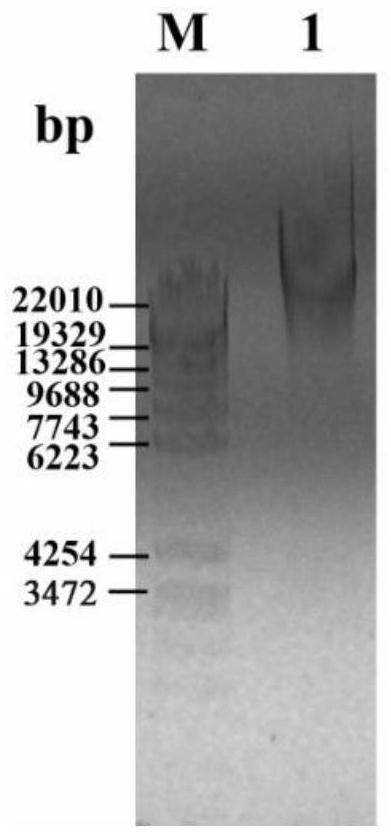Carbohydrate binding module CBM6B protein capable of specifically recognizing xanthan gum side chains and application
A carbohydrate and protein technology, applied in the biological field, can solve problems that have not yet been tried, and achieve the effect of improving affinity and catalytic ability, and improving enzyme activity.
- Summary
- Abstract
- Description
- Claims
- Application Information
AI Technical Summary
Problems solved by technology
Method used
Image
Examples
Embodiment 1
[0040] Example 1 Construction of carbohydrate binding module CBM6B expression vector
[0041] A. Extraction of Microbacterium sp.XT11 genomic DNA (CTAB / NaCl method)
[0042] Microbacterium sp.XT11 (the xanthan gum-degrading bacterium XT11 screened from the soil by our laboratory has the number AB2016011 of the China Center for Type Culture Collection, and the accession number of the genome sequence in the DDBJ / EMBL / GenBank database is CP013859).
[0043]Collect 10 mL of fresh Microbacterium XT11 seed liquid by centrifugation at 4°C, and resuspend and wash the cells with pure water. The cells were lysed with 20 μL of lysozyme at a concentration of 10 mg / mL, added with 1 mL of 1×TE, mixed gently, and reacted at 37 °C for 1 h. After the reaction, the cells were transferred to a new 2 mL imported centrifuge tube, 10 μL of 10 mg / mL proteinase K and 60 μL of 10% SDS were added in sequence, mixed well, and reacted at 37°C for 1 h.
[0044] Add 100 μL of 5M NaCl and 80 μL of CTAB / Na...
Embodiment 2
[0050] The construction of the fusion expression vector of embodiment 2 carbohydrate activity enzyme CtCel8A and CBM6B
[0051] A high-activity cellulase was selected as the object of transformation, and it was fused with the substrate binding domain CBM6B to construct a new type of xanthan endonuclease.
[0052] A. Using PCR technology to amplify the coding gene of endocellulase CtCel8A
[0053] The codon-optimized sequence of the high-activity endocellulase CtCel8A from Clostridium thermocellum (genebank: CP016502.1) synthesized by the whole gene is shown in SEQ ID NO.5. The specific reaction system and reaction conditions of PCR are as follows: 150ng pUC57-CtCel8, 30 μL 5×PrimeSTAR Buffer, 15 μL dimethyl sulfoxide (DMSO), 30 μM each of upstream and downstream primers (upstream primer sequence such as SEQ ID NO.6, downstream primer sequence As shown in SEQ ID NO.7), 12 μl of 2.5mM dNTPs, 3.75U PrimeSTAR DNA polymerase, and 150 μL of pure water. The reaction parameters were...
Embodiment 3
[0057] The construction of the fusion expression vector of embodiment 3 carbohydrate activity enzyme MiXen and CBM6B
[0058] Select the catalytic domain sequence MiXen-CD of the xanthan endonuclease MiXen from the xanthan gum degrading bacteria Microbacterium sp.XT11, see SEQ ID NO.8 (genebank: LX1-1GL001095), and express it in fusion with the substrate binding domain CBM6B , to construct a novel xanthan endonuclease.
[0059] A. Using PCR technology to amplify the coding gene of carbohydrate binding module CBM6B
[0060] The specific reaction system and reaction conditions of PCR are as follows: 150ng pET28a-CBM6B, 30 μL 5×PrimeSTARBuffer, 15 μL dimethyl sulfoxide (DMSO), 30 μM each of the upstream and downstream primers (the sequence of the upstream primer is as SEQ ID NO.9, and the sequence of the downstream primer is as SEQ ID NO.9). ID NO.10), 12μl 2.5mM dNTPs, 3.75U PrimeSTAR DNA polymerase, and 150μL of pure water. The reaction parameters were: pre-denaturation at 95...
PUM
 Login to View More
Login to View More Abstract
Description
Claims
Application Information
 Login to View More
Login to View More - R&D
- Intellectual Property
- Life Sciences
- Materials
- Tech Scout
- Unparalleled Data Quality
- Higher Quality Content
- 60% Fewer Hallucinations
Browse by: Latest US Patents, China's latest patents, Technical Efficacy Thesaurus, Application Domain, Technology Topic, Popular Technical Reports.
© 2025 PatSnap. All rights reserved.Legal|Privacy policy|Modern Slavery Act Transparency Statement|Sitemap|About US| Contact US: help@patsnap.com



